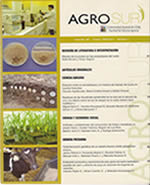Estimation of inbreeding in a dual-purpose dairy herd and its relationship with milk production and reproductive performance: A case study in Southern Chile
Main Article Content
Abstract
The objective of the study was to estimate the degree of inbreeding in a commercial dairy herd of Red Dual Purpose Breed and its effects on number of days between calvings, age at first calving and milk production, using recorded data from 157 cows. The inbreeding index was calculated by using the software Pedigree Viewer, developed by Brian Kinghorn from the US Center for Livestock Genetic Evaluation. A file was created for each predigree, then every file was uploaded onto Pedigree Viewer to calculate the inbreeding coefficient on an individual basis. Twenty-four out of the 157 cow had some degree of inbreeding. The effect of inbreeding on number of days between calvings, age at first calving and milk production was then estimated but no effects were found. Results suggest that inbred cows might have a genetic superiority for the analyzed characteristics when compared with non-inbred cows. It is concluded that, at least in this case, the depression produced by inbreeding was balanced by the genetic superiority of the inbred cows.

